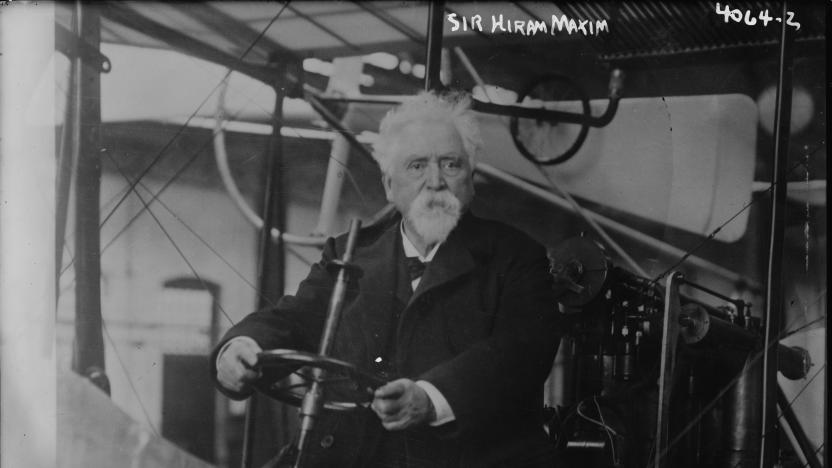invention
Latest

Hitting the Books: Why nobody knows Hiram Maxim, inventor of the incandescent lightbulb
In "The Things We Make, Dr. Bill Hammack, recounts the tale of Hiram Maxim, an irrepressible engineer whose novel filament production method would have made him a household name — had Thomas Edison not helped himself to Maxim's design.

UK appeals court rules AI cannot be listed as a patent inventor
Add the United Kingdom to the list of countries that says an artificial intelligence can’t be legally credited as an inventor.

AI can't be legally credited as an inventor, says USPTO
Patent law only allows 'natural persons' to be credited, the agency determined.

ICYMI: Harnessing mother nature's fury for energy
try{document.getElementById("aol-cms-player-1").style.display="none";}catch(e){}Today on In Case You Missed It: A Japanese engineer created a wind turbine that can harness energy from both typhoons and hurricanes, watch the video of it here. Meanwhile, researchers at Northwestern University developed a 3D printed bone made of ceramic and polymer materials that can encourage bone to regrow itself once it's implanted. Scripps Institution for Oceanography had bad news for humanity this week after the group said the world's carbon levels went over 400 parts per million. There are three RIP items in the news this week, so get acquainted with the Rosetta Probe's storied history, Blackberry's decision to stop making its own handsets, and camera wearable company Narrative deciding to call it a day. As always, please share any interesting tech or science videos you find by using the #ICYMI hashtag on Twitter for @mskerryd.

EVE Evolved: Features coming in Oceanus and beyond
It's been almost four months since EVE Online switched from publishing two major expansions per year to releasing ten smaller updates, and so far it looks like the new schedule has been a huge success. Rather than forcing the industry overhaul out the door in Kronos before it was ready, CCP was able to push it forward to the Crius release window seven weeks later and the extra development time meant the feature launched in a very polished state. It may be too early to tell if the new schedule's success can be seen in the concurrent player graph for Tranquility, but the numbers have remained steady for the past few months in what is typically the annual low-point for player activity. The Oceanus update is scheduled to go live in just two day's time, adding several graphical upgrades, more difficult burner missions, an experimental new notification feature, and other small improvements. The scale of the update seems to be on par with the recent Hyperion release, consisting of mostly small features and minor iterations on gameplay. While we're told that CCP is still working on large projects behind the scenes, the new release schedule means they won't be rushed out the door and so we may not see them for some time. In this edition of EVE Evolved, I summarise everything we know about Tuesday's Oceanus update, and take a look at what's to come in further releases.

EVE Evolved: Making ISK from the Crius release
EVE Online's economy has been studied over the years for its resemblance to the real world, and it is often cited as an example of a hyper-capitalist society with no laws or regulation. But underneath the emergent interplay of supply and demand that has fueled everything from freighter businesses to virtual investment banks, EVE is ultimately a game. The biggest influence on the markets by far has always been CCP Games and the changes it deploys in expansions, which shake the universe up and force players to adapt to new circumstances. There's always money to be made from major gameplay changes, and accurately predicting how an expansion will impact on the market can put you on the head of a short-lived but very lucrative gold rush. Though EVE's updates now come in the form of ten smaller releases per year, the upcoming Crius release scheduled for July 22nd has practically a whole expansion's worth of changes to industry and research. That gives you just over two weeks to prepare for the change, train any skills you might need, and figure out how to cash in on EVE's industrial revolution. In this edition of EVE Evolved, I run down some tips for how to prepare for the upcoming industry revamp in Crius and make some ISK.

White House will host its first Maker Faire later this year
Many will tell you that Maker Faires inspire entrepreneurs, and the White House certainly agrees -- it wants to foster that inventive spirit across the US. Accordingly, it just unveiled plans to host the first-ever White House Maker Faire later in 2014. Details of the competition are coming later, but the government is already encouraging builders to share their creations through both email and Twitter. The upcoming Faire is part of a broader initiative that will encourage support for maker spaces and startups. We wouldn't expect the event to create the next Elon Musk, but it might just give indie gadget designers the exposure (and potentially, funding) they crave.

Cardboard bicycle 'close to mass production': tough, green and just $20
Cardboard never ceases to amaze. Having been deployed in gramophones, stereos and even digital cameras, one inventor now believes it can be used to make the ideal bicycle. Izhar Gafni, from Israel, spent 18 months just folding the material every-which-way in order to discover a strong enough design, and now he claims his technique is almost ready for mass production. His maintenance-free bike uses a "secret" mix of organic materials to make it waterproof and fireproof, and is then lacquered to give it a friendlier appearance. It's expected to cost a mere $20 and weigh about 20 lbs (9 kg) -- that's 65 percent lighter than an average metal ride. In fact, this bicycle doesn't use any metal parts at all -- the solid tires are made of reconstituted rubber and a car timing belt is used instead of a chain. It lacks the swank of a Faraday Porteur, perhaps, but then you could buy 175 of these for the same money. Want proof that it actually works? The bike's not-so-featherweight inventor takes it for a spin after the break. [Image credit: Reuters / Baz Ratner]

Kickstarter brings crowdfunding to the UK on Halloween
Whether you're currently keeping calm, or simply carrying on, we've got some good news for you steadfast Brits: Kickstarter makes its official launch in the UK on October 31st. Sure, its arrival was rather inevitable, but All Hallows' Eve will mark the first time that inventors outside of the US can take part in the crowdfunding website. Kickstarter visitors will find UK projects listed alongside those in the US, and inventors who think they've stumbled upon the next great mousetrap may begin work on their listing today. Naturally, Insert Coin fans are bound to find some nifty projects work their way across the pond, but in the meantime, you can check out the commerce-related details at the source link below.

World's oldest color film footage discovered in museum archive (video)
Cached away for over a century, the world's first color moving pictures have been shown for the first time yesterday, according to the National Media Museum in the UK. The celluloid, shot by inventor Edward Raymond Turner in 1899, was actually in black and white and it was only through a curator's research that its colorful significance was also unearthed. When the footage was first shot, each frame was run consecutively through red, green or blue gels, and the process needed to be reversed during projection to reveal the color. Fortunately, a blueprint by the inventor of how to do just that was also found, allowing the institution's team to replicate the process digitally to produce the final footage. This type of color gel processing didn't take off in the early 20th century due to the mechanical complexity, and it would have been inferior to a chemical process since each frame carried only one-third of the full color information. Still, it required a clever mind to dream it up, with an equally big brain to uncover it and finally give Turner his due. See the video below the break for the stunning un-retouched, non-hand-colored results. [Image Credit: National Media Museum]

Bluetooth dock adapter Pear disappears from Kickstarter, founders promise return under new name
You might remember Pear, a recent Insert Coin debutant that connects your favorite iDevice dock to (almost) any Bluetooth-connected smartphone. However, you probably didn't notice its swift disappearance from Kickstarter just before the weekend. The people behind the project have contacted us, explaining that the crowdfunding site was hit with a cease and desist order for the dock converter, centering around a "trademark infringement issue." With its funding page down, Pear says it had no way to tell its supporters that product development would continue, albeit under a new name. Anyone that funded the project is advised to register at the source link below to keep up-to-date. The founders aim to return to Kickstarter in around 3-6 weeks, with several as-yet unannounced enhancements coming alongside a new logo and moniker -- something that it's going to task its backers with deciding.

Insert Coin: Stabil-i case reduces iPhone camera shake, fits in your pocket (video)
In Insert Coin, we look at an exciting new tech project that requires funding before it can hit production. If you'd like to pitch a project, please send us a tip with "Insert Coin" as the subject line. Ah, stability, a commodity valued by videographers who want to produce footage that won't make their viewers throw up. Reducing camera shake can be especially tricky when using a smartphone such as the iPhone, whose form factor and light weight make it easier to have the shakes while shooting. Currently, options for reducing camera vibration in iPhone videos include apps like the Dolly Cam and more hardware-oriented solutions such as the Steadicam Smoothee. Our latest Insert Coin candidate, the Stabil-i, happens to use the latter route, serving up a "video stabilization iPhone case" that's still reasonably affordable. According to its creators, the Stabil-i's design is based on concepts found in larger, more expensive camera stabilization systems used in the film industry -- minus 90 percent of the hardware and the expensive bearing system. The result, they say, is a device that does a good job in reducing camera shake while still being compact enough to fit in one's pockets.

Insert Coin: Botiful telepresence robot for Android (video)
In Insert Coin, we look at an exciting new tech project that requires funding before it can hit production. If you'd like to pitch a project, please send us a tip with "Insert Coin" as the subject line. Remote-controlled cameras are nothing new -- heck, some even ride atop robotic vacuums -- but this Android smartphone-powered device delivers quite a bit of versatility in a petite package with a reasonable price tag to boot. Botiful, a "social telepresence robot," serves as a roving platform for your Android smartphone. You can move the handset (and its front-facing camera) up and down as it speeds along any flat surface, responding to commands from someone on the other end of a Skype video chat. Once you connect the device to your Android phone through Bluetooth or USB, you can control its direction from a pop-up window within Skype, letting you position Botiful however you see fit. If your Android phone doesn't have a front-facing camera, you can flip it around to use the rear shooter -- of course, you won't be able to see the display in this configuration, so it won't be ideal for two-way chats. Naturally, this makes the duo a natural choice for surveillance and baby monitoring, but it can also be used to provide a more immersive experience during conference calls or for sending back video from locations that aren't easily accessible, such as the undercarriage of a car. Designed in a garage in California (no, really), Botiful is already functional, with working software as well. The current configuration requires Skype for control, though an SDK will allow developers to create other control apps for the device -- and who knows, the seemingly capable inventor could release another tool of her own before it's set to hit production later this year. With much of the design already completed, the project sponsor is turning to Kickstarter to raise the funds necessary to launch Botiful to production -- the device could ship as soon as November if it reaches a $90,000 goal before August 22nd. Available in white, blue or red, the remote-controlled rig is currently only compatible with Android, though iOS support may come if funding exceeds a $100k threshold. There's still more than three weeks to go to make your pledge, with a limited number of pre-order slots available for $199 (retail pricing is expected to come in at $299). Hit up the source link below to show your support.

Insert Coin: Pear brings Bluetooth to your Apple-compatible speaker dock
In Insert Coin, we look at an exciting new tech project that requires funding before it can hit production. If you'd like to pitch a project, please send us a tip with "Insert Coin" as the subject line. What a lovely set of speakers. Let me just dock my smartphone right th... Or perhaps you happen to own one of the thousands of devices not equipped with a proprietary Apple dock connector. Well, when it comes time to slide your Android or Windows Phone into place, the only sound you're likely to hear is the screech of a 30-pin plug scratching up the case. If the speaker rig packs Bluetooth, you can use that instead, but if you own one of many that don't, you'll probably want Pear. Drawing some name and design inspiration from an arguably more popular fruit, Pear brings Bluetooth connectivity to any dock connector-equipped speaker set, drawing power from the port so it can pair with virtually any smartphone or tablet, letting you play your tunes while keeping your handset in hand. It offers a range of 30 feet indoors or up to 75-feet outside (there's a video proving the feat at the source link below), and works with any apps and devices that offer Bluetooth output. The wireless gadget's designer is turning to Kickstarter to raise the funds necessary to launch Pear into production. The team has already developed a working prototype, so there's proof that you're not backing vaporware, and a $30 pledge can net you one of 250 early bird devices. After that initial run, you'll need to hand over 40 bucks (which also happens to be the expected retail place) for an arctic white or jet black Pear. The developers are hoping to raise $40,000, to cover their prior investments and push the device to the manufacturing stage (no, it won't be "made in the USA"), so if you want to see Pear pop up in a speaker dock near you, hit up our source link below to make your pledge. You can also jump past the break for a quick intro video, and an update on a previous Insert Coin project.

Kickstarter sends some love to Europe, will support UK projects beginning this fall
Kickstarter's US-based micro funding site has seen measurable success on this side of the Atlantic, and it looks like the company is planning to capitalize on that momentum, bringing its service to the United Kingdom later this year. A company spokesperson was unable to comment on the move beyond what was offered up in an earlier tweet, but judging by the 110 characters you see above, it appears that Kickstarter plans to open the site up to UK projects beginning this fall, with more information to come at a later date. That 140-character limit is hardly to blame for the micro-size tease, with much space to spare even beyond that rather informal sign-off -- it seems that the site just wants to get its ducks in a row before revealing more. For now, feel free to hit up the source link below to read the post and share your thoughts on Twitter.

Insert Coin: LUMOback Smart Posture Sensor thrums when you slouch, charts your laziness (video)
In Insert Coin, we look at an exciting new tech project that requires funding before it can hit production. If you'd like to pitch a project, please send us a tip with "Insert Coin" as the subject line. LUMOback wants to show all those DIY posture dilitantes what's what with its Smart Posture Sensor, an app and hardware combo that tracks your carriage and vibrates when you hunch. The thinnish 8.5mm sensor is worn like a belt, and on top of the tactile nagging, it provides detailed iPhone or iPad charting of the sitting, running and even sleeping you did, complete with an xkcd-like stickman video replaying all your crooked moves. So far the team is about a third of the way to its $100K mark, and a minimum $99 pledge will get you a jet-black model if it's built, with a $125 chip-in letting you vote on a a second shipping color, to boot. If some of your activities consist of, say, blogging in front of a computer screen all day, check the video after the break for relief.

Microsoft patent app wants SMSs in your spreadsheet, so you can Excel while you excel
If you're too busy racking up commissions to submit your expense report, a Microsoft patent application might let you text that steak-dinner-schmoozefest straight to a spreadsheet in accounting. That's one use that pops to mind for the proposed invention, which which could permit text and multimedia messages to interact with Redmond's Office suite. It could then process that info and redirect the message or send you a reply, confirming your shenanigans. Now, how to justify that $1,500 bottle of cognac? [Image Credit: Shutterstock]

Arthur P. Stern, instrumental in inventing the color television and GPS, passes away
Engadget learned that Arthur P. Stern passed away on May 24th, 2012, but just this week, The Los Angeles Times has published a laudable look back at a man that had an enormous impact on the technology that we rely on -- and, quite frankly, take for granted -- each and every day. Born in 1925 in Budapest, Hungary, Arthur went on to obtain an M.E.E. from Syracuse University, joining General Electric in 1951 and making a near-immediate impact in the realm of television. He's widely credited with pioneering the color TV that we're familiar with today (and holding a related patent -- number 2920132 -- granted in December of 1953), while also publishing initial technical papers on transistor radios. As if that weren't enough, he was also instrumental in the progress of GPS, spearheading the development of key elements in the latter portion of his career. As fantastic as Stern was as an inventor, he was also a beloved grandfather to Joanna Stern, one of the industry's premiere technology reporters. Currently, Joanna works at ABC News, though she has spent time at LAPTOP Magazine, The Verge and right here at Engadget prior. From the entire staff, our deepest sympathies go out to a wonderful colleague and peer. The world has lost a brilliant mind, but on a personal level, a friend has lost much more.

Kickstarter talks to us about product 'pre-orders,' won't force refunds when creators flake
Kickstarter has proven an incredibly effective venue for connecting project creators with monetary support -- inventors pitch directly to consumers, indie filmmakers meet indie producers and food trucks get the financial push necessary to take their restaurants to the road. With the latter two, backers don't necessarily expect goods in return, save for an overvalued t-shirt, bumper sticker or film credit. When it comes to electronics, however, funders are often promised a first-off-the-line gadget -- one that may never arrive at their door. One oft-overlooked, yet critical detail should help curb expectations, while also serving to filter out pledges that are motivated by the pre-order promise, from those that offer financial support without a guaranteed return. Like it or not, all transactions fall into that second category. Pre-order offers may go unfulfilled, and some pledges may be reduced to donations, if a project creator ends up unable to deliver an item as intended. And such situations may not prompt a refund, souring the experience for an increasing number of hopeful device owners. Join us past the break for an explanation from the Kickstarter team, and a closer look at some recent examples.

Google Doodle celebrates Gideon Sundback, unzips knowledge about your favorite wearables
We've covered no shortage of wearable gizmos over the years here at Engadget -- in fact, we've given 'em their own category -- but we most certainly haven't spent enough time praising one of the pioneers of the segment. Thanks to a highly pleasing Google Doodle, we're given the perfect chance to take a harder look at one Gideon Sundback, the electrical engineer responsible for developing the zipper. It's been called a "fly," prominently featured in an Outkast song and positively shunned on the Snuggie, and it's also a huge, huge part of worldwide culture. For those looking to learn more about the man, the myth and the mystery, head on down to the Wikipedia link below; if you just want to unzip your browser, well... click here.












